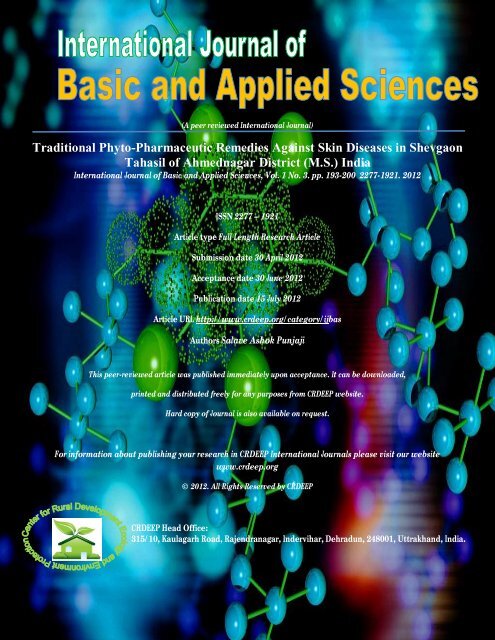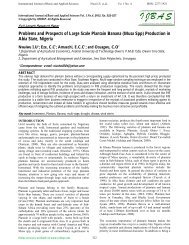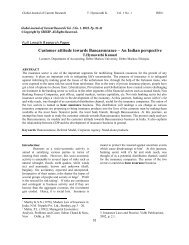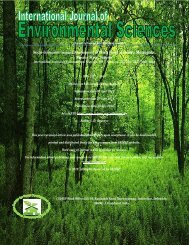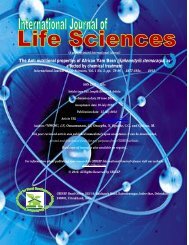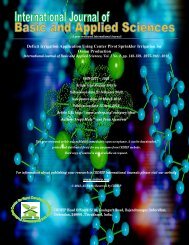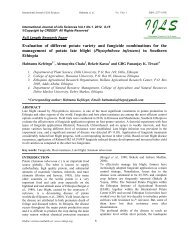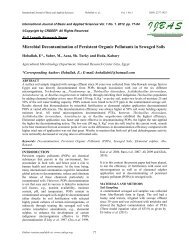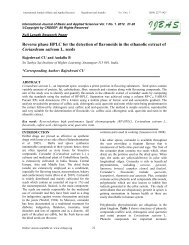Download Pdf - CRDEEP
Download Pdf - CRDEEP
Download Pdf - CRDEEP
You also want an ePaper? Increase the reach of your titles
YUMPU automatically turns print PDFs into web optimized ePapers that Google loves.
International Journal of Basic and Applied Sciences Salave Ashok Punjaji Vol. 1 No.3 ISSN: 2277-1921<br />
(A peer reviewed International Journal)<br />
Traditional Phyto-Pharmaceutic Remedies Against Skin Diseases in Shevgaon<br />
Tahasil of Ahmednagar District (M.S.) India<br />
International Journal of Basic and Applied Sciences, Vol. 1 No. 3. pp. 193-200 2277-1921. 2012<br />
ISSN 2277 – 1921<br />
Article type Full Length Research Article<br />
Submission date 30 April 2012<br />
Acceptance date 30 June 2012<br />
Publication date 15 July 2012<br />
Article URL http://www.crdeep.org/category/ijbas<br />
Authors Salave Ashok Punjaji<br />
This peer-reviewed article was published immediately upon acceptance. It can be downloaded,<br />
printed and distributed freely for any purposes from <strong>CRDEEP</strong> website.<br />
Hard copy of Journal is also available on request.<br />
For information about publishing your research in <strong>CRDEEP</strong> International Journals please visit our website<br />
www.crdeep.org<br />
© 2012. All Rights Reserved by <strong>CRDEEP</strong><br />
<strong>CRDEEP</strong> Head Office:<br />
315/10, Kaulagarh Road, Rajendranagar, Indervihar, Dehradun, 248001, Uttrakhand, India.<br />
Online version available at: www.crdeep.org
International Journal of Basic and Applied Sciences Salave Ashok Punjaji Vol. 1 No.3 ISSN: 2277-1921<br />
International Journal of Basic and Applied Sciences Vol. 1 No. 3. 2012. Pp. 193-200<br />
©Copyright by <strong>CRDEEP</strong>. All Rights Reserved.<br />
Full Length Research Paper<br />
Traditional Phyto-Pharmaceutic Remedies against Skin Diseases in Shevgaon<br />
Tahasil of Ahmednagar District (M.S.) India<br />
Salave Ashok Punjaji<br />
Department Of Botany, Shri Dnyaneshwar Mahavidyalaya,Newasa,Dist-Ahmednagar- 414603<br />
Abstract<br />
An extensive field surveys were arranged in Shevgaon tahasil areas of Ahmednagar district to document traditional herbal remedies used<br />
against cut and wounds. The information is collected during the period from 2008 to 2010, from the local informants through verbal<br />
interviews via informal ways. The paper focuses on the ethno-medicinal uses of 43 plant species belonging to 37 genera from 27 families<br />
used against certain kind of skin diseases and related disorders among the local inhabitants.<br />
Keywords: Herbal remedy, Shevgaon tahasil, Traditional knowledge.<br />
Introduction<br />
Human interactions with the surrounding environment,<br />
especially plants have been started since the ancient period<br />
due to which the modern medicines have been arrived at the<br />
end of 20 th century. Being a part and parcel of the nature, man<br />
has found busy in utilizing the wild plants for certain needs<br />
and necessities such as food, medicine, fodder, agricultural<br />
tools, house construction etc. It has been realized in recent<br />
years that most of the plants were in use by the traditional<br />
healers, hakims and ethnic societies of the world either as a<br />
food or as herbal drugs in the ancient time. Since the last three<br />
to four decades, due to the recent explorations considerable<br />
progress has been made in the field of ethno-medicinal<br />
remedies.<br />
Use of these plants and their parts had contributed so much to<br />
the field of ethno-medicinal science by fulfilling the social and<br />
cultural needs of the rural, aboriginal and tribal people. These<br />
plant based herbal drugs are relatively safe [1], affordable,<br />
easily available in the market and are manufactured with the<br />
traditional eco-friendly methods. They can work selectively<br />
without disturbing the other system as compared to modern<br />
synthetic drugs.<br />
Study area<br />
Being a beautiful landscape, Shevgaon is one of the tahasil in<br />
the Ahmednagar district famous for the rich ethno-floristic<br />
diversity. It is situated on the north-east west side of the<br />
district at a distance of 26 km. It is located between<br />
18°16’33”N - 19°35’58”N latitude and 73°86’68”E -<br />
77°68’38”E longitude. The area under the study is occupied<br />
by 33% of mixed type of vegetation and experiences an<br />
average rainfall of 221.8 cm/yr [2]. It has remained inhabited<br />
to certain extent by the native inhabitants for certain needs and<br />
necessities for curing specific livestock ailments.<br />
The information from the inhabitants is documented from the<br />
study area to understand importance and significance of the<br />
native ethno-flora in the life of local inhabitants.<br />
Figure 1- Map of the study area<br />
Review of literature<br />
Recent interest in ethno-medicinal explorations has increased<br />
due to the work of [3-8].<br />
Methodology<br />
Frequent field visits were arranged in the study areas during<br />
the period from pre-monsoon of 2008 to post-monsoon of<br />
2010 to collect the ethno-medicinal data on uses of the wild<br />
ethno-flora by the local inhabitants. The plant specimens were<br />
collected by knowing their vernacular names through the help<br />
of knowledgeable informants as per guidelines [9-10]. The<br />
information was confirmed through the traditional healers<br />
through verbal and informal interviews.<br />
The voucher specimens were prepared, tagged and confirmed<br />
by referring the standard floras [11-13] and preserved as per<br />
plan [14] in the Botany Dept of the college for future study.<br />
Online version available at: www.crdeep.org<br />
193
International Journal of Basic and Applied Sciences Salave Ashok Punjaji Vol. 1 No.3 ISSN: 2277-1921<br />
Enumeration/Result<br />
The plant species enumerated here are arranged alphabetically<br />
according to botanical name with family (in parenthesis)<br />
followed by vernacular name, plant part used and traditional<br />
medicinal uses. Unknown or less known ethnobotanical uses<br />
are marked with an asterisk (*) sign.<br />
Table: 1-Detailed analysis of the plant species used in skin diseases cure:<br />
S.<br />
No.<br />
Botanical Name with<br />
familly<br />
Manilkara hexandra<br />
(Roxb.) Dubard.<br />
(Sapotaceae)<br />
Sapindus laurifolius<br />
Vahl.<br />
(Sapindaceae)<br />
<br />
Solanum torvum Sw.<br />
(Solanaceae)<br />
Ziziphus xylopyra<br />
(Retz.)Willd.<br />
(Rhamnaceae)<br />
Euphorbia nerifolia L.<br />
(Euphorbiaceae)<br />
Ficus racemosa L.<br />
(Moraceae)<br />
Ficus religiosa L.<br />
(Moraceae)<br />
Local name Occurence Habit Plant<br />
Part<br />
Herbal formulations for treatment<br />
Khirani Rare Tree Fruit *Aatpav fresh or young fruits are crushed in a half<br />
cup of coconut (Cocos nucifera) oil to obtain fine<br />
paste which is applied externally twice a day up to<br />
13-15 days to cure ringworm and scabies.<br />
Ritha Rare Tree Fruit A cup of juice from young fruits in luke warm<br />
water is mixed with 2-3 tsp of korphad (Aloe vera)<br />
leaf juice and resultant preparation is applied on the<br />
scalp twice or thrice in a week before bath up to 6-8<br />
successive weeks to clear dandruff.<br />
Ranvange<br />
Introduced<br />
plant<br />
species<br />
Herb Fruit 1-2 unripe fruits are crushed in a cup of sheep’s<br />
urine with 1-2 tsp of lasun (Allium sativum) cloves<br />
extract to obtain paste which is applied externally<br />
on the affected skin twice a day up to 8-10 days to<br />
cure small pox.<br />
Ghotbar Rare Tree Fruit Fine paste from a 2-3 tolas fresh and young fruits in<br />
a cupful goat’s urine is mixed with little quantity of<br />
hing (Ferula asafoetida) powder and 1-2 tsp of<br />
Kate ringani (Solanum xanthocapum) fruits and<br />
resultant preparation is applied topically on the<br />
affected skin regions twice a day up to 8-9 days to<br />
clear Shingles (Herpes zoaster).<br />
Shingoti Common Shrub Exudates<br />
(latex)<br />
Umbar Common Tree Exudat<br />
es<br />
(latex)<br />
Pimpal Common Tree Exudates<br />
(latex)<br />
*Fine paste from 2-3 tsp of latex and equal quantity<br />
of dried Papaya(Carica papaya) latex is mixed in a<br />
half cup of coconut oil and the mixture is applied<br />
externally at an interval of 15-20 minutes until total<br />
relief from scorpion bite.<br />
*Specific quantity of latex mixed is with a pinch of<br />
common salt and same paste is applied on the body<br />
region twice a day up to certain days to cure<br />
shingles (Herpis zoaster).<br />
*A cupful of plant latex is boiled with 1-2 tsp of<br />
turmeric powder in a cup of coconut oil to obtain<br />
homogeneous paste which is applied externally<br />
twice a day for 8-9 days to cure ringworm.<br />
Agave americana<br />
Linn.<br />
(Liliaceae)<br />
Ghaypat<br />
An exotic<br />
ornamental<br />
Herb<br />
Leaf<br />
Paste from a handful of fresh leaves in luke warm<br />
coconut (Cocos nucifera) oil is applied externally<br />
once a day in the early morning for 10-12 days to<br />
get rid of mange in goats and cattle.<br />
Argemone mexicana<br />
L.<br />
(Papaveraceae)<br />
Bilayat Common Herb L<br />
Leaf<br />
An extract from 2-3 tolas of young and fresh leaves<br />
is mixed with 1-2 tsp of turmeric powder in a cup of<br />
Mahua (Madhuca indica) oil and the paste is<br />
applied topically once a day for 8-10 days to cure<br />
scabies, ringworm and psoriasis.<br />
Online version available at: www.crdeep.org<br />
194
International Journal of Basic and Applied Sciences Salave Ashok Punjaji Vol. 1 No.3 ISSN: 2277-1921<br />
<br />
Aristolochia<br />
bracteolata Lam.<br />
(Aristolochiaceae)<br />
Gindhan Common Herb Leaf 2-3 tolas fresh leaves are crushed in a half cup of<br />
goat’s urine with a tsp of sunth (Zingiber officnale)<br />
rhizome extract and the paste is applied externally<br />
twice a day up to 5-8 days to cure acne and eczema.<br />
Azadirachta indica A.<br />
Juss.<br />
(Meliaceae)<br />
<br />
Bacopa monnieri (L.)<br />
Penn.<br />
(Scrophulariaceae)<br />
Kadunimb<br />
Nir<br />
brahmi<br />
Common Tree Leaf Fine paste from aatpav fresh and healthy leaves in<br />
coconut (Cocos nucifera) water is applied<br />
externally once a day for 8-10 days to cure certain<br />
kind of skin diseases such as ringworm, scabies<br />
and chicken pox.<br />
Rare Herb Leaf *An extract from a handful of fresh leaves in a glass<br />
of cow’s urine is mixed with 1-2 tsp of honey to<br />
obtain paste which is applied externally once a day<br />
in early morning up to 20-22 days to cure shingles.<br />
Balanites agyptiaca<br />
(L.) Del.<br />
(Balanitaceae)<br />
Cleome gynandra L.<br />
(Capparaceae)<br />
Hingan Common Shrub Leaf A handful of fresh leaves are crushed with a pinch<br />
of common salt in a cup of coconut (Cocos<br />
nucifera) oil and the formulation is applied two to<br />
three times in a day up to 15-18 days to cure skin<br />
burns and measles.<br />
Pandhri tilwan Common Herb Leaf Fine paste from a handful of fresh leaves with haldi<br />
(Curcuma domestica) powder and common salt (a<br />
tsp each) in little amount of coconut (Cocos<br />
nucifera) oil is applied on boils.<br />
<br />
Convolvulus<br />
arvensis L.<br />
(Convolvulaceae)<br />
Curcuma anguistata<br />
Valet. Syn.C. longa L.<br />
(Zingiberaceae)<br />
<br />
<br />
Jatropha curcas Linn.<br />
(Euphorbiaceae)<br />
Jatropha gossypifolia<br />
L.<br />
(Euphorbiaceae)<br />
Lawsonia inermis L.<br />
(Lythraceae)<br />
Leonotis nepetifolia<br />
(L.) R.Br.<br />
(Acanthaceae)<br />
Chandvel Common Herb Leaf A handful of fresh leaves are boiled in sufficient<br />
quantity of goat’s urine with a pinch of common<br />
salt, 1-2 tsp of haladi (Curcuma domestica) powder<br />
and some Lasun (Allium sativum) cloves extract to<br />
obtain paste which is applied once or twice in a<br />
week on the scalp to cure dandruff and folliculitis.<br />
Ambe-<br />
Herb Leaf *A fine paste made from a handful of fresh leaves<br />
halad Cultivated<br />
and adrak (Zingiber officinale) rhizome in a half<br />
crop plant<br />
cup of Mohri (Brassica compestris)seed oil is<br />
applied superficially around the neck once daily for<br />
9-12 days to cure heel cracks, toes, lips cracks.<br />
Parshi Erand Common Shrub<br />
Paste from a handful of tender and healthy leaves<br />
Leaf are crushed with 4-6 lasun (Allium sativum) cloves<br />
in a cup of goat’s urine is applied externally on the<br />
affected skin regions twice a day up to 6-8 days to<br />
cure ringworm and scabies.<br />
Mogali erand Common Shrub Leaf *An extract from 8-10 fresh leaves are crushed with<br />
a pinch of sulphur powder in a cupful of coconut<br />
(Cocos nucifera) oil to get a homogeneous paste<br />
which is mashed on the affected skin regions twice<br />
a day up to 8-10 days to cure scleroderma.<br />
Mehandi Rare Shrub Leaf A cupful of extract from fresh and young leaves in<br />
water is mixed with equal quantity of amla<br />
(Phyllanthus emblica) fruit juice and this mixture is<br />
kept over night burried in an earthen pot. On next<br />
day morning same formulation is applied topically<br />
on the scalp twice in a week up to 15-21 days to<br />
stop premature graying of hairs and alopecia.<br />
Mathyasul Rare Herb Leaf Poultice specific quantity of fresh and healthy<br />
leaves is boiled with 1-2 tsp of haldi (Curcuma<br />
domestica) powder and a pinch of common salt in<br />
sufficient quantity of Til (Sesamum indicum)seed<br />
oil and above formulation is applied externally on<br />
Online version available at: www.crdeep.org<br />
195
International Journal of Basic and Applied Sciences Salave Ashok Punjaji Vol. 1 No.3 ISSN: 2277-1921<br />
affected skin twice a day up to 12-15 days to cure<br />
folliculitis.<br />
<br />
<br />
<br />
Lepidagathis cristata<br />
Willd.<br />
(Acanthaceae)<br />
Mukia maderaspatana<br />
(L.) Roem.<br />
(Cucurbitaceae)<br />
Pongamia pinnata (L.)<br />
Pierre.<br />
(Fabaceae)<br />
Spheranthus indicus L.<br />
(Asteraceae)<br />
<br />
<br />
Triumfetta<br />
rhomboidea Jacq.<br />
(Tiliaceae)<br />
Aloe vera (L.) Burm.<br />
(Liliaceae)<br />
Bosswellia serrata<br />
Roxb.ex.Coleb.<br />
(Lythraceae)<br />
<br />
<br />
Abelmoschus<br />
mannihot (L.) Medik<br />
(Malvaceae)<br />
Abutilon indicum (L.)<br />
Sweet.<br />
(Malvaceae)<br />
Kumbha Rare Herb Leaf A handful of fresh leaves are crushed with 1-2 tsp<br />
of haldi (Curcuma domestica) powder and 1-2 tsp<br />
of Kanda bulb (Allium cepa) extract in a cup of<br />
Mohri (Brassica compestris) oil is boiled and above<br />
preparation is applied externally twice a day up to<br />
10-12 days on the infectious skin region to cure<br />
ringworm and eczema.<br />
Chirmuth Rare Climber Leaf An extract from a handful of fresh and tender<br />
leaves are boiled in a half cup of pig ghee and<br />
above formulation is applied on the scalp once a<br />
day up to 10-12 days at night to control dandruff<br />
and also to stop premature graying of hairs.<br />
Karanj Common Tree Leaf A handful of fresh leaves and equal quantity of<br />
kadu neem (Azadirachta indica) leaves are crushed<br />
in a cupful of cow’s urine with a pinch of haldi<br />
(Curcuma domestica) powder to obtain fine paste<br />
which is applied on the affected skin thoroughly<br />
twice a day up to 10-12 days to cure itching, scabies<br />
and ringworm.<br />
Gorakh mundi Rare Herb Leaf *Poultice from a handful fresh leaves is boiled with<br />
3-4 lasun (Allium sativum) cloves and 1-2 tsp of<br />
sunth (Zingiber officinale) powder in a cupful of<br />
goat’s milk and above formulation is applied<br />
externally twice a day up to 12-15 days to cure<br />
psoriasis.<br />
Zinjurdi Common Herb Leaf *A handful of fresh leaves are crushed with a pinch<br />
of common salt and a tsp of sunth (Zingiber<br />
officinale)powder in a half cup of Til (Sesamum<br />
indicum) seed oil to obtain fine paste which is<br />
applied topically on the affected skin twice a day up<br />
to 10-12 days to cure chicken pox.<br />
Korphad<br />
An exotic<br />
ornamental<br />
Herb<br />
Exudates<br />
(Mucilage)<br />
Salai Rare Tree Exudates<br />
(Resin)<br />
Two-three tsp of mucilage from the leaves is mixed<br />
in 1-2 tsp of cow’s urine with two to three drops of<br />
lemon (Citrus limon) juice and above formulation is<br />
applied topically twice or thrice a day for 10-12<br />
days to cure skin burns and itching.<br />
2-3 tsp of fresh resin is mixed with equal quantity<br />
of kadu neem (Azadirachta indica) leaves extract<br />
in a cup of cow’s urine and above preparation is<br />
applied externally twice a day up to 12-15 days to<br />
cure sores, skin burns and itching.<br />
Ranbhendi Common Herb Root paste from a handful of fresh and healthy roots<br />
with a pinch Haldi (Curcuma domestica) powder<br />
and equal amount of sunth (zingiber offcinale)<br />
powder in a cup of cow’s urine is mashed twice a<br />
day up to 8-12 days to cure skin burns.<br />
Petari Common Herb Root *Paste from young and healthy roots in sufficient<br />
quantity of water applied topically on the affected<br />
body regions once a day up to 12-15 days to cure<br />
ringworm<br />
Online version available at: www.crdeep.org<br />
196
International Journal of Basic and Applied Sciences Salave Ashok Punjaji Vol. 1 No.3 ISSN: 2277-1921<br />
Adiantum capillusveneris<br />
L.<br />
(Adiantaceae)<br />
Amberboa ramosa<br />
(Roxb.)Jafri.<br />
(Asteraceae)<br />
Cassia occidntalis L.<br />
(Caesalpinaceae)<br />
<br />
<br />
Clitoria ternatea var<br />
alba Linn.<br />
(Fabaceae)<br />
Ipomoea nil (L.) Roth.<br />
(Convolvulaceae)<br />
Hansraj Rare Fern Root An extract from root powder is mixed in 1-2 tsp of<br />
Lasun (Allium sativum) cloves extract, a tsp of<br />
Haldi (Curcuma domestica) powder and same<br />
quantity of sunth (Zingiber officinale) powder and<br />
the paste is rubbed thoroughly twice a day up to 10-<br />
12 days to get rid of pimples,warts and lesions in<br />
girls attaining adultery.<br />
Katmanda Rare Herb Root Fine paste from a handful of fresh roots in a cup of<br />
rice cooked water is mixed with 1-2 tsp of Lasun<br />
(Allium sativum) extract and a pinch of haldi<br />
(Curcuma domestica) powder is applied externally<br />
on the skin twice a day for 10-12 days to cure skin<br />
inflammation and irritation due to eczema.<br />
Kasundi Common Herb Root A handful of fresh root pieces are crushed with a tsp<br />
of Haldi (Curcuma domestica) powder and a pinch<br />
of common salt in sufficient amount of Til<br />
(Sesamum indicum) oil to form a paste which is<br />
applied topically twice a day for 10-12 days to cure<br />
Safed Gokarn<br />
An exotic<br />
ornamental<br />
skin burns and itching.<br />
Shrub Root A handful of fresh roots are crushed with of haladi<br />
(Curcuma domestica) powder, sunth (Zingiber<br />
officinale) powder (1 tsp each) in a cup of sheep’s<br />
urine and the preparation is massaged on face<br />
thoroughly once a day at night before sleep up to<br />
10-12 days to clear acne, pimples and scars.<br />
Nili phungali Common Herb Root *Paste from a handful of fresh roots pieces in a half<br />
cup of Til (Sesamum indicum) oil is applied on the<br />
skin of feet and toes twice a day up to 12-15 days to<br />
cure crypto-coccosis.<br />
<br />
Abelmoschus<br />
moschatus Medik.<br />
(Malvaceae)<br />
Cassia fistula L.<br />
(Caesalpinaceae)<br />
<br />
Semecarpus<br />
anacardium<br />
(Anacardiaceae)<br />
Kastur bhendi Rare Herb Seed *Fine paste from a handful of fresh and young seeds<br />
is mixed with 1-2 mase of lasun (Allium sativum)<br />
seeds extract in a cup of mustard (Brassica<br />
compestris) seed oil is applied externally on the<br />
body twice a day for 8-9 days to cure small pox.<br />
Bahava Common Tree Seed *A handful of young seeds are crushed with 1-2 tsp<br />
of haldi (Curcuma domestica) powder in a half cup<br />
luke goat’s milk and above paste is applied<br />
topically on the body region twice a day against<br />
herpes zoaster (shingles).<br />
Bibba Rare Tree Seed The oil extracted from burnt dried seeds is mixed in<br />
L.f.<br />
little quantity of bees wax and above preparation is<br />
applied externally on cracked heels, toes and fingers<br />
once daily at night for 9-12 days to heal.<br />
<br />
Cissus quadrangularis<br />
L.<br />
(Vitaceae)<br />
Kandvel Rare Shrub Stem Young stem pieces with a pinch of common salt are<br />
crushed in sufficient amount of coconut (Cocos<br />
nucifera) oil and the paste applied against<br />
folliculitis.<br />
<br />
Bridelia retusa (L.),<br />
Spreng.<br />
(Euphorbiaceae)<br />
Asan Rare Shrub Stem<br />
(bark)<br />
A handful of fresh stem bark is boiled in a cup of<br />
kadu neem (Azadirachta indica) seed oil and same<br />
preparation is recommended for taking a bath once<br />
or twice in a week up to 6-8 weeks to cure measles<br />
and scleroderma.<br />
Online version available at: www.crdeep.org<br />
197
International Journal of Basic and Applied Sciences Salave Ashok Punjaji Vol. 1 No.3 ISSN: 2277-1921<br />
<br />
Cissus repanda Vahl.<br />
(Vitaceae)<br />
Ficus arnottiana<br />
(Miq.) Miq.<br />
(Moraceae)<br />
Madhuca latifolia<br />
(Roxb.) Chevalier.<br />
(Sapotaceae)<br />
Morinda citrifolia L.<br />
(Rubiaceae)<br />
Ghetuli Common Shrub Stem<br />
(bark)<br />
Pair Rare Tree Stem<br />
(bark)<br />
Moha Rare Tree Stem<br />
(bark)<br />
Bartondi Rare Tree Stem<br />
(bark)<br />
*Poultice from fresh and young stem bark pieces in<br />
luke warm water with a pinch of Haldi (Curcuma<br />
domestica) powder is applied topically at the site of<br />
wasp bite at an interval of 15-20 minutes until relief<br />
from skin burns and irritation due to wasp stings.<br />
*Aatpav shade dried stem bark powder, equal<br />
quantity of bhui ringni (Solanum surattense) fruit<br />
powder are crushed with a pinch of hing (Ferula<br />
asafoedita) powder in a cup of cow’s urine and the<br />
formulation is applied topically once a day at night<br />
up to 16-18 days to cure chicken pox.<br />
An extract from fresh stem bark pieces is mixed in a<br />
cupful of mustard (Brassica compestris) seed oil<br />
and equal quantity of lemon (Citrus limon) fruit<br />
juice with a pinch of common salt and the<br />
formulation is applied externally twice a day up to<br />
6-8 days to cure small pox.<br />
1-2 tsp of the shade dried stem bark powder is<br />
boiled in a cupful of coconut (Cocos nucifera) oil<br />
with a few drops of the Ransher (Sarcostema<br />
viminale) latex and above formulation is applied<br />
externally on the affected skin regions once a day<br />
up to 12-15 days to cure sores and boils.<br />
Abbreviations: tsp-tablespoon, 1 masa-1 gm, tola-10 gm, aatpav-100 gm, A handful-250 gm, 1 cup-100 ml, half litre -500 ml.<br />
Discussion<br />
During the field visits (table:1) 43 plant species belonging to 37<br />
genera from 27 families used against certain kind of skin<br />
diseases and related disorders by the local inhabitants have been<br />
reported from the study areas. These plants have been utilized<br />
by the local inhabitants in curing cut and wounds in traditional<br />
ways. Some of the taxa i.e Ficus arnottiana (Pair), Cissus<br />
repanda (Ghetuli),Cissus quadrangularis (Kandvel),<br />
Abelmoschus moschatus (Kastur bhendi), Amberboa ramosa<br />
(Katmanda), Madhuca latifolia (Moha), Morinda citrifolia<br />
(Bartondi), Bosswellia serrata (Salai), Spheranthus indicus<br />
(Gorakh mundi), Pongamia pinnata (Karanj), Abutilon indicum<br />
(Petari), Abelmoschus mannihot (Ranbhendi), Aloe vera<br />
(Korphad), Bridelia retusa (Asan) and Semecarpus anacardium<br />
(Bibba) possess better potential for economic exploitation.<br />
Since all these plant species are in use in more or less<br />
proportion throughout the world, have wide scope for bioprospecting.<br />
Therefore it is our prime duty should be to<br />
protect, conserve and maintain it in a proper way for our<br />
future studies.<br />
Table: 2- Plant parts used in number of plant species with<br />
their percentage:<br />
Out of the plant species studied (table:2), majority of the<br />
preparations (i.e.13) are from leaves (37.14%) followed by<br />
exudates in five plant (14.29%),roots and stem and fruits parts<br />
in four plants (11.43% each), rhizomes and seed parts in two<br />
plants each (5.71% each )and whole plant parts in one plants<br />
(2.86%),found to have uses in cut and wounds treatments.<br />
Habit Herb Shrub Tree Climber Fern<br />
No. of plants species 19 09 13 01 01<br />
% of plant species used 44.19 20.93 30.23 2.33 2.33<br />
Table: 3- Habit wise analysis of the plants with their<br />
percentage:<br />
Out of the plant species studied (table:3),majority of the plants<br />
i.e nineteen plants are herbs (44.19%) followed by thirteen<br />
plants trees (30.23%), nine plants shrubs (20.93%), one plant<br />
climber(2.33%) and remaining one plant each found climber<br />
and fern (2.33% each).<br />
Plant part used Root Leaf Seed Stem Fruit Rhizome Exudates Whole plant<br />
No. of plant sp. 04 13 02 04 04 02 05 01<br />
% of parts used 11.43 37.14 5.71 11.43 11.43 5.71 14.29 2.86<br />
Online version available at: www.crdeep.org<br />
198
International Journal of Basic and Applied Sciences Salave Ashok Punjaji Vol. 1 No.3 ISSN: 2277-1921<br />
Table: 4- Occurrence wise analysis of the plants with their<br />
percentage:<br />
Out of the 43 plant species,(table:4),nineteen plant species<br />
each are common as well as rare (44.19%)which are followed<br />
by three plant species an exotic ornamental (6.98 %) and<br />
remaining one plant each found cultivated crop plant and<br />
introduced plant species (2.33 %).<br />
Occurrence Rare Common Cultivated Introduced plant An exotic<br />
crop plant species ornamental<br />
No. of plants species 19 19 01 01 03<br />
% of plant species used 44.19 44.19 2.33 2.33 6.98<br />
Conclusion<br />
The area under the study is enriched by great ethno-medicinal<br />
knowledge hidden among the traditional healers,<br />
knowledgeable local informants, vaidyas and hakims reside in<br />
the nearby villages which are transmitted to them from their<br />
forefathers through oral communications in an informal ways<br />
from their forefathers [15].<br />
There are a number of plants which are used traditionally<br />
against certain kind of skin diseases and related disorders by<br />
the local rural and tribal populace have not been validated<br />
until now keeping the traditional claims in mind. Most of the<br />
phyto-pharmacological reports of herbal extracts need<br />
scientific screening. Most of their traditional claims about the<br />
plants use in certain kind of skin diseases and disorders<br />
treatments involves application of fresh plant parts, their paste<br />
and extracts in water or oil. One has to remember that there<br />
are a number of parameters which are involved in the<br />
treatment of skin diseases and related disorders needs to be<br />
evaluated scientifically to understand exact role of the plant<br />
part in the traditional system of medicine which will help in<br />
strengthening the ethno-medicinal and ethno-pharmacological<br />
claims on national and international level.<br />
Most of the traditional wealth of knowledge in India is eroding<br />
at faster rate due to loss of the ancient traditions and culture as<br />
they are mostly oral [16]. Due to their continuous and<br />
progressive exposure to modernization, there is serious threat<br />
about extinction of such rich heritage of information in the<br />
coming time. Effort should be initiated for the documentation<br />
and computerization of useful medicinal plants and their<br />
traditional knowledge [17].<br />
Acknowledgement<br />
Author’s thanks are due to the help rendered by the notified<br />
and de-notified rural, tribal and non-tribal groups and<br />
traditional healers from areas under the study due to the help<br />
and co-operation during the study and field work. Thanks are<br />
also due to the authorities of Ahmednagar Forest division for<br />
cooperation and permission for collection of plant parts from<br />
plants of ethno-medicinal significance to prepare voucher<br />
specimens.<br />
References<br />
Iwu, M.W.,Duncan, A.R. and Okunji, C.O. “New<br />
antimicrobials of plant origin”. In J. Janick (ed.), Perspectives<br />
on new crops and new uses.ASHS Press, Alexandria,<br />
VA.,(1999),457-62.<br />
Almeida, M.R. A Checklist of Plants of Ahmednagar district.<br />
Enercon, Orient Press Ltd. Bombay, (2007)348p.<br />
Janaki Ammal, E.K. Introduction to the subsistence economy<br />
of India. In: Man’s role in changing face of the earth<br />
(edr.William L.T. Jr),University of Chicago Press, Chicago,<br />
(1956),324-35.<br />
Jain, S.K. Ethnobotany: Its scope and study in India.<br />
J.Museum Bull.2 (I):39-43.<br />
Badame A.J., Incidence of skin diseases in rural Jamaica.<br />
Intern. J Dermatolog. 1988; 27:109-11.<br />
Failmezger T.C.,A clinical survey of skin diseases in selected<br />
Latin American countries. Intern. J Dermatolog. 1978; 17:<br />
583-91.<br />
Mahé A, Cisse I.A., Faye O., Thiam N’Diaye H. and<br />
Niamba P. Skin diseases in Bamako (Mali). Intern. J.<br />
Dermatolog. 1998; 37:673-6.<br />
Porter M.J., Mack R.W., Chaudhary M.A., Pediatric skin<br />
disease in Pakistan. Intern. J.Dermatolog. 23,(1984), 613-16.<br />
World Health Organization. Guidelines for the management of<br />
sexually transmitted infections. Geneva: World Health<br />
Organization, (2001),WHO/RHR/01.10.<br />
Schulte, R.E. The role of ethnobotanists in search for new<br />
medicinal plants.Jr.Lloydia.25 (4) (1962)257-66.<br />
Jain, S.K. and Rao R.R. A handbook of field and herbarium<br />
methods, Today and Tomorrow Printers and Polishers, New<br />
Delhi,(1967),33-58.<br />
Singh, N.P. and Karthkeyan S. Flora of Maharashtra state<br />
(Dicots) Vol I & II., BSI., Calcutta,(2000),421p.<br />
Pradhan, S.G. and Singh N.P. Flora of Ahmednagar<br />
District.(M.S.).Bishen Singh Mahendrapal Singh. Dehradun,<br />
(1999),511p.<br />
Jain, S.K. Methods and approaches in Ethnobotany, Society<br />
of Ethnobotanists, C.D.R.I. Lucknow, (1989). 259.<br />
Hamilton, A. The people and plants initiative. In: Martin,<br />
G.J.(edr.) Ethnobotany: A Methods Manual. WWF<br />
International Chapman & Hall, London, (1995),10-11.<br />
Online version available at: www.crdeep.org<br />
199
International Journal of Basic and Applied Sciences Salave Ashok Punjaji Vol. 1 No.3 ISSN: 2277-1921<br />
Mehrotra, S. and Mehrotra B.N. Role of traditional and folk<br />
lore herbals in the development of new drugs. J. Ethnobot.<br />
17(1), (2005), 104-11.<br />
Ayyanar, M. and Ignacimuthu S. Traditional Knowledge of<br />
Kani tribals in Kouthalai of Tirunelveli hills, Tamilnadu,<br />
India, J.Ethnopharmacol 102,(2005),246-55.<br />
Online version available at: www.crdeep.org<br />
200


